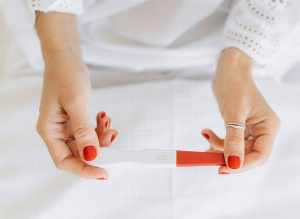Endometriosis: What impact does it have on fertility?
Published 28 Mar 2022 • By Candice Salomé
Endometriosis is a chronic gynaecological condition, quite common among women of childbearing age. It is characterised by the development of the uterine lining (the endometrium) outside the uterus, that spreads to the neighbouring organs. One of the consequences of endometriosis is impaired, or reduced, fertility, which affects 30 to 40% of women suffering with this condition.
But what is the link between endometriosis and infertility? What are the possible remedies?
We explain it all in our article!

What is endometriosis and what are its symptoms?
In the UK, endometriosis affects around 10% of women of childbearing age, being the second most common gynaecological condition (after fibroids). However, as it is difficult to get diagnosed (it is estimated that it takes an average of 7 years to establish a diagnosis), the figures may be underestimated. Patients with endometriosis suffer from diagnostic wandering, leading to inappropriate management of their symptoms and even aggravation of the disease.
Endometriosis is a chronic gynaecological disease affecting women of reproductive age. This condition is characterised by the development of the uterine lining (called the endometrium) outside the uterus. The endometrium then migrates to the surrounding organs.
Endometriosis is a complex disease the symptoms of which vary from woman to woman.
The main symptoms of endometriosis include:
- Pain during menstruation,
- Pain during sexual intercourse (dyspareunia),
- Regular pelvic pain,
- Umbilical and/or abdominal pain,
- Back pain, sometimes pain in the legs as well,
- Painful bowel movements,
- Difficulty urinating (dysuria).
The organs most often affected by deep endometriosis are:
- ovaries,
- uterosacral ligaments,
- rectum,
- bladder,
- vagina.
The major symptom of endometriosis is recurrent and sometimes very acute pelvic pain, particularly during menstruation. The cyclical nature of the disease can help suggest the diagnosis. Lesions caused by endometriosis are sensitive to female hormones, therefore, they proliferate, bleed and leave fibrous scars with each menstrual cycle.
What is the link between endometriosis and infertility?
Endometriosis is often diagnosed during an infertility evaluation, and it is often associated with infertility. However, not all women with endometriosis are concerned. Only 30 to 40% of patients actually get diagnosed with infertility.
The degree of fertility impairment usually depends on the severity of the disease. However, even a few painless and unrecognised sites of inflammation caused by endometriosis may lead to infertility.
Fertility requires several conditions:
- Ovulation,
- The unimpeded movement of the egg along the tube to the uterus,
- Fertilisation,
- Implantation of the fertilised egg,
- Sufficient number, appearance and mobility of the spermatozoa.
In the case of endometriosis, the abnormalities may be detected in the ovaries, the fallopian tubes or the surrounding peritoneum. Endometriosis causes inflammation and irritation of the tissues during the menstrual cycle, releasing biochemical factors that interfere with the maturation of the egg.
When endometriosis affects the ovaries more than other organs, cysts can form. The maturation of the eggs is then directly disturbed, making "normal" ovulation impossible.
If endometriosis is present in the fallopian tubes and ovaries, the egg may not be taken up through the fallopian tube and its journey to the uterus becomes thus impeded.
The immune defence reaction against endometriosis lesions can also prevent the implantation of the fertilised egg in the womb.
Adenomyosis, a particular form of endometriosis affecting the uterine muscle, can also interfere with the implantation of the fertilised egg in the uterine cavity.
What can you do about infertility when you are affected with endometriosis?
Many doctors advise patients with endometriosis not to delay their first pregnancy for too long. This is because the condition creates an environment that is incompatible with fertilisation.
Nevertheless, if pregnancy cannot occur spontaneously, patients can turn to medically assisted procreation (MAP), which implies such techniques as ovarian stimulation, artificial insemination or in vitro fertilisation (IVF).
Ovarian stimulation
This technique is recommended for patients suffering with ovulation disorders or unexplained infertility. It aims at stimulating the production of eggs and their maturation.
The doctor prescribes hormones in the form of injections, the gonadotropins. These hormones are naturally secreted by the pituitary gland (an endocrine gland located at the base of the brain) the role of which is to stimulate the activity and hormonal secretion of the gonads (ovaries and testicles).
During treatment, regular ultrasound checks allow the development of the follicles (which contain the eggs) to be monitored in order to limit the risk of multiple pregnancies (e.g. twins) and to trigger ovulation at the right moment.
Artificial insemination
Intrauterine artificial insemination (AI) with the spouse's sperm consists of injecting "prepared" sperm into the uterine cavity on the day of the patient's ovulation.
Stimulation of the ovaries helps to control and improve ovulation.
The sperm is prepared in the laboratory, in order to reproduce the actions of the cervical mucus, and the selected specimen are then injected into the uterus.
This technique allows to bypass the cervical mucus and bring the sperm closer to the ovocytes.
In vitro fertilisation (IVF)
In vitro fertilisation (IVF) consists of reproducing in the laboratory what happens naturally in the fallopian tubes: fertilisation and the first stages of embryo development.
Stimulation of the ovaries allows the development of several follicles, each containing an egg. A puncture is made to collect several eggs.
The collected eggs are then placed in the presence of spermatozoa outside the human body, in an embryology laboratory.
There are two types of in vitro fertilisation:
- Conventional IVF. This type simply consists of placing the collected eggs in the presence of a previously treated sperm sample in a specific nutrient medium. Fertilisation then takes place according to the natural process but outside the human body.
- ICSI (intracytoplasmic sperm injection) IVF. This method involves a single sperm cell being injected into the egg. Both the egg and the sperm have to be treated beforehand.
Was this article helpful to you?
Give it a like and share your thoughts and questions with the community in the comments below!
Take care!
Sources:
Prendre en charge l’endométriose : le ministère s’engage, Ministère des solidarités et de la santé
Infertilité et endométriose, EndoFrance
Quelles sont les conséquences de l'endométriose sur la fertilité ?, Hôpitaux Universitaires Genève
Infertilité et Endométriose, Fondation de l’AP-HP
Endométriose - Une maladie gynécologique fréquente mais encore mal connue, INSERM
Stimulation de l'ovulation, Médecine de la fertilité et endocrinologie gynécologique
Insémination artificielle avec sperme du conjoint (IAC), Hôpitaux de Toulouse

 Facebook
Facebook Twitter
Twitter


